 Should my next vehicle be gas, diesel, or how about electric? Up until a year… ok, maybe even a few years ago, most “normal” people wouldn’t have really considered that last one even as an option. Now that they are becoming more of a legitimate choice that will work for many, the times have changed from gas versus diesel to now include electric – so just which vehicle would be best? Well like most things the answer is “it depends.” Well let’s take a look at all three options, some gotchas many don’t tell you about & even skewer a few old wives tales, and let you make up your mind as all three options have their pros & cons.
Should my next vehicle be gas, diesel, or how about electric? Up until a year… ok, maybe even a few years ago, most “normal” people wouldn’t have really considered that last one even as an option. Now that they are becoming more of a legitimate choice that will work for many, the times have changed from gas versus diesel to now include electric – so just which vehicle would be best? Well like most things the answer is “it depends.” Well let’s take a look at all three options, some gotchas many don’t tell you about & even skewer a few old wives tales, and let you make up your mind as all three options have their pros & cons.
Regular Cars:
Spoiler alert – diesel is essentially dead here in the US as far as cars are concerned, especially after Volkswagen’s fiasco with the EPA. I think it was back in 2018 there were only 11 makes of regular cars for sale that had a diesel option. Now I don’t see any cars unless you are looking into certain SUV’s & trucks. We will cover trucks & SUV’s specifically in the next piece where we get into hauling and other aspects. So now we are down to Electric versus Gas which brings us to an issue – just how do you compare them.
MPG versus ??? / Range:
One of the most looked at items (albeit one rarely used to make a buying decision) is what is the cars MPG? For gas cars everyone knows how that number is arrived at, how it works, & shoot they might even monitor it. Fortunately, they have also started doing this with certain diesel vehicles now so that can help with taking some guess work out of that buying process & can allow one to compare those costs side by side, but…
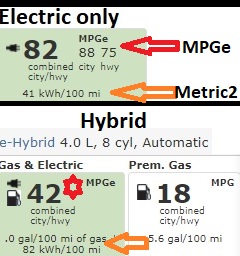 For electric cars on the other hand, the EPA came up with a crazy MPGe “marketing” metric which you can see on the left in red. Supposedly the MPGe is an equivalent MPG rating for electric cars to allow one to compare them to “gas” vehicles. Got a hybrid, well that just gets confusing as you can see by the sticker below the electric only.
For electric cars on the other hand, the EPA came up with a crazy MPGe “marketing” metric which you can see on the left in red. Supposedly the MPGe is an equivalent MPG rating for electric cars to allow one to compare them to “gas” vehicles. Got a hybrid, well that just gets confusing as you can see by the sticker below the electric only.
The problem with this though, is it is essentially meaningless. Their next favorite metric is XX kWh (used) / (per) 100 miles which is shown in orange. Yeah, that doesn’t help many people either going just how far can I drive, and secondly or even trying to figure out just how much does it cost to fill it back up.
In most cases every gas vehicle is generally going to go 300 miles before you really need to fill it back up. An electric cars “range” though can vary from as little as 35 miles (mainly hybrids) up to 250+ miles depending on battery size, use, etc… That is a big range and if you don’t have enough range or know how to calculate it, some of those savings you are thinking you might get, just won’t be there & you might as well have just gone with gas.
How about a more meaningful number?
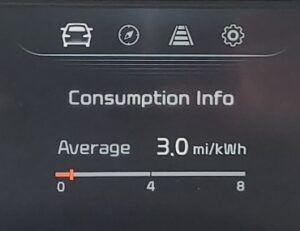
Ahh, now here’s a useful number – essentially how many miles per kWh are you using? I like to call it MPK or Miles Per Kilowatt hour. Now you can not only figure out how many miles you can go (assuming you know the size of the battery) but you can then also use that to figure out how much it will cost to charge it back up at home.
Unfortunately, you won’t find that number on many sites because as they will quickly point out, it can vary based on numerous conditions (just like MPG) and they just report the EPA’s numbers. So here is a quick conversion chart to take a reported number & turn it into something a tad more meaningful.
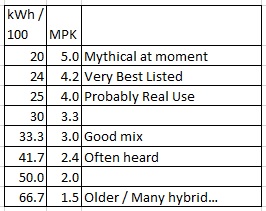
The chart is pretty self-explanatory & uses the reported kWh / 100 number. Just using basic division gets you a base MPK number. You may note that 5.0 is “mythical” at the moment but don’t expect it to be for long as I have known a few drivers to get better than that on some road trips and technology is developing rapidly. With that it is just like MPG – a lot depends on how you drive, maintenance, etc... Don’t believe me – just check out Tesla’s page on “Range.” Thus 4.2 is “best listed” while 4.0 is probably going to be “real use” though for calculating most cars you are better off planning on 2.4 or 3 for newer ones while 1.5 covers earlier cars, many hybrids, etc…
MPG / MPK Cost:
Now we can start comparing apples to apples in a sense – How much does it cost to fill the “tank” for a regular commute, or maybe even a longer trip / weeks’ worth of use? I have two charts below, the first is for gas & the second is for Electric. The left size on both deals with a typical commute distance (16 miles each way with a stop off to say a grocery store) of 35 miles & goes up to 300 miles for say a vacation. The next column is either for what is your MPG or MPK followed by how much gas or electricity was used. You may also notice two rows – in gas for 10 MPG & Electric for 1.5 MPK. The 10 MPG will be in a later piece while the 1.5 MPK is was basically used for older electric vehicles — though the hybrid example shown above is worse than that – darn sports cars 🙂
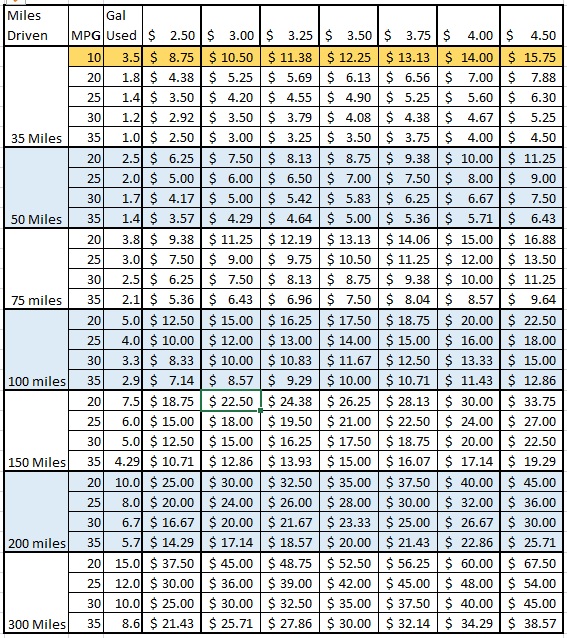
Gas prices is easy as I show some typical prices for gas you will find across the country – at the moment I am writing this they range from a low of almost $3 a gallon to over $4.50 in Hawaii. Man, I miss when gas was only 99¢ a gallon, but wow would that throw off the “savings.”
 Hey now wait a minute, everyone knows we are going to hit $5 a gallon due to this war in Ukraine &… Sorry, but I started & did these charts before that flare up started & quite honestly it is a blip. Most of the prices shown above fall in the normal range for what we have seen over the last few years and as history has shown in the past, we will see these numbers again. May $5 a gallon become a new normal? Yes it can, but it probably wont be for another decade or two. On the flip side, just remember that electric is also going to increase and as the push continues to electrify everything, it will probably climb faster than gas prices. Hey now wait a minute, everyone knows we are going to hit $5 a gallon due to this war in Ukraine &… Sorry, but I started & did these charts before that flare up started & quite honestly it is a blip. Most of the prices shown above fall in the normal range for what we have seen over the last few years and as history has shown in the past, we will see these numbers again. May $5 a gallon become a new normal? Yes it can, but it probably wont be for another decade or two. On the flip side, just remember that electric is also going to increase and as the push continues to electrify everything, it will probably climb faster than gas prices. |
This chart below is for electric vehicles & to figure out your fill “cost” you would need to know what your kWh charge is. As of right now, 3 states are sitting at 8¢ or less, .106 is “average” for the US, .125 is what I currently pay, California is sitting at .18 & last but not least Hawaii is kicking back at a cool 27.6¢. Why include such higher costs – well if history is any indicator, prices are only going to go up and with the push for electrification, well… FYI – don’t just believe the charts you see out there on cost – Illinois was listed at 9.75¢ but as shown my cost is 12.5¢.
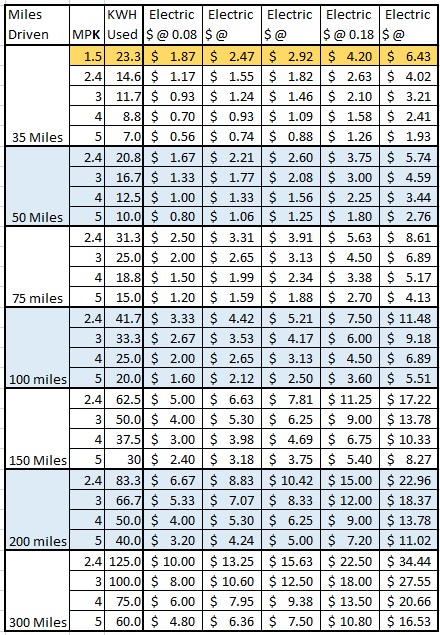 So just for fun, let’s do a few quick comparison – Hawaii & the car you have now or want to get, gets 30 MPG. Ahh but that Tesla at 2.4 KWH look good to and we will be nice and say both cars cost the same. So the Tesla for 35 miles runs $4.02 compared to $5.25 for gas – that looks like a no brainer. Shoot look at 300 miles which might be your average week, I will save over $10 a week or $520 a year which means in 10 years I will save $5,200. While some nice savings that isn’t really that great.
So just for fun, let’s do a few quick comparison – Hawaii & the car you have now or want to get, gets 30 MPG. Ahh but that Tesla at 2.4 KWH look good to and we will be nice and say both cars cost the same. So the Tesla for 35 miles runs $4.02 compared to $5.25 for gas – that looks like a no brainer. Shoot look at 300 miles which might be your average week, I will save over $10 a week or $520 a year which means in 10 years I will save $5,200. While some nice savings that isn’t really that great.
Shall we go with National averages – same situation as above… That comes to $4.08 for 35 miles or $35 for 300 miles for gas compared to $1.55 / $13.25 or a nice savings of $1,131 a year or $11,310 for 10 years – that sounds a lot more like it right? Wow this is a no-brainer, electric wins on the fill up side. Sign me up, right?
 Now wait a second, I thought I could fill up for free as I have heard many mention it – sorry folks, those days are long gone. When charging stations were first set up you could plug in for free as one was not allowed to charge for the electricity as only the utility could do that. So many did it as a perk, exclaimed how green they were, etc… Now wait a second, I thought I could fill up for free as I have heard many mention it – sorry folks, those days are long gone. When charging stations were first set up you could plug in for free as one was not allowed to charge for the electricity as only the utility could do that. So many did it as a perk, exclaimed how green they were, etc…
Since then though, many have either had laws rewritten or they use a work around and charge you for renting the space whether you are filling up or not so your prices can be higher than shown. For example, one individual states that filling up at home runs $16, while charging up on the road can be $20 to $45 for the same amount of juice. This also doesn’t include any app or network monthly charges. |
Charging / Fill Up:
Fueling up a regular car is easy, you stop at a gas station insert a credit card & fill up the tank. If the station is to busy, you just might keep driving & hit the next one. Ahh but they have a really good price, so I will wait – shoot, there are only two cars in front of me… Heh, I have an electric car so I just fill up at my house so I don’t have to worry about that. Ok lets just focus on that at the moment which brings us to our next chart – just how long does it take to charge your car?
Home Chargers:
Ahh before we get to that, we need to cover “chargers.” There are essentially 3 level of chargers. Your L1 chargers are essentially you simply plugging in an extension cord into an outlet aka 120 volt. This is typically called a trickle charger now as the size of batteries has grown exponentially & rarely will be able to fill up the tank in a timely fashion. L2 is 240 volt or as some like to call it using a “large” dryer outlet. L3 is three phase power which is used for speed charging and generally only available in commercial settings which is why you don’t see it on the chart.
The number next to Charger Level is (KWH that can be provided to the car). Both are broken out with two different KWH settings. For example, the first level 1 is using a simple extension cord, while the second is a beefed up cable provided with the car. L2 – there are plenty that go into higher values but these are three of the more standard options. The catch – the more power you wish to deliver to the car, requires larger breakers and wiring. Got two cars & oh boy you might need two 40- amp breakers (or larger) which could easily trip some major electric work to maybe even a separate service being needed.
 Wow, this new L2 charger I bought is awesome, I can use this app and it lets me decide what amps I can allow for it to pull (or split between vehicles) so I can use a smaller breaker or wires right? This question does come into play when one is calculating out the loads / sizing required for pulling the permit – you might find out you are limited to say 20 or 30 amps for “charging,” but the charger might require a 40-amp breaker… (i.e. the L2 @ 6.6 below / more on this in the next piece) Wow, this new L2 charger I bought is awesome, I can use this app and it lets me decide what amps I can allow for it to pull (or split between vehicles) so I can use a smaller breaker or wires right? This question does come into play when one is calculating out the loads / sizing required for pulling the permit – you might find out you are limited to say 20 or 30 amps for “charging,” but the charger might require a 40-amp breaker… (i.e. the L2 @ 6.6 below / more on this in the next piece)
Well, you do need a 40-amp breaker and the appropriate wiring using the example above as they are rated on what loads can be applied. Now some places may “interrupt” this differently, but for most they are worried about what happens if said software controlling this resets to default… Generally the only way you can derate an item is with jumpers &/or an appropriate sized disconnect. If in doubt make sure you contact your AHJ before just going off what a salesman says. |
Charging Times:
The math is quite simple, once you know what charger you will be using (aka how much it can deliver) coupled with just how much power you need to top your batteries back off that can tell you how long you need to charge your vehicle. Ahh but what happens if you don’t know what size charger you should choose or… That leads us to this chart which is based on the same layout used above assuming you know your base mileage:
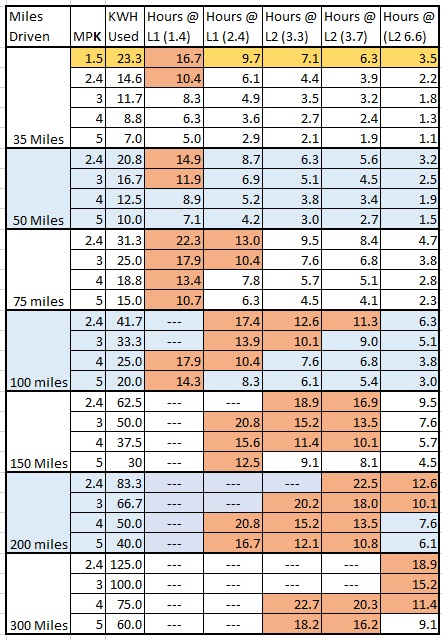
Essentially, I based this off someone able to have their vehicle plugged in for 10 hours or less a day. If you see a number in red that means it will take longer than the time allotted for that charger & you should either, be looking at upgrading your charger, or getting a more efficient vehicle. If you see “—” that means it would take more than a day to charge your battery.
Now for most of us, we also use our vehicles on the weekend, maybe to see grandma in another town – this will help you see if your charger can handle that type of trip or you might have to upgrade or seek out other options so you can get back to normal by Monday morning.
Road Trips / Vacations:
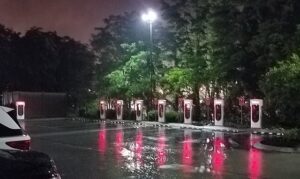 We will be delving into this more in the next piece (along with other items) but be forewarned – you do have some additional planning you will need to do if you have an electric vehicle.
We will be delving into this more in the next piece (along with other items) but be forewarned – you do have some additional planning you will need to do if you have an electric vehicle.
First many newer cars allow for rapid or speed charging where they can “fill” your batteries in 20 to 30 minutes. One big catch on this is they will only bring your batteries up to 80% at that rapid charge rate but the last 20% (not in that 20 or 30 minutes) the speed has to be backed off so as not to cause damage to the batteries. If you are anything like me where I drive straight through and don’t want to spend hours sitting around while waiting for your battery to be fully filled up, you need to plan on reduced range.
Another question, is there a charger where you are going for your specific vehicle? Are there other options in case it is out (yes it does happen), or as alluded to above backed up because if you have two cars in front of you, you are looking at almost an hour of down time, assuming everyone is only speed charging. If someone is fully topping off or just parked it while they go shopping and have lunch… well it can be a lot longer. Fortunately, there are apps that can help on planning, but planning & reality don’t always work out. For example, one hotel I was at had 3 charging spots & all three spots were filled & the three cars parked there for two days never budged. Now if you are in California or other places with a good network of charging stations you might be fine, but in many other locals…
Coming Up:
First, I hope this has helped clear up some questions you might have on cost & range as it applies to miles driven followed up by home charging options. Coming up we will delve more into Level 3 chargers, Maintenance needs, Diesel, SUV’s, Trucks, Towing, and a host of other items revolving around just what is your best option. If you have any comments or questions, we would love to hear from you below. Thanks
